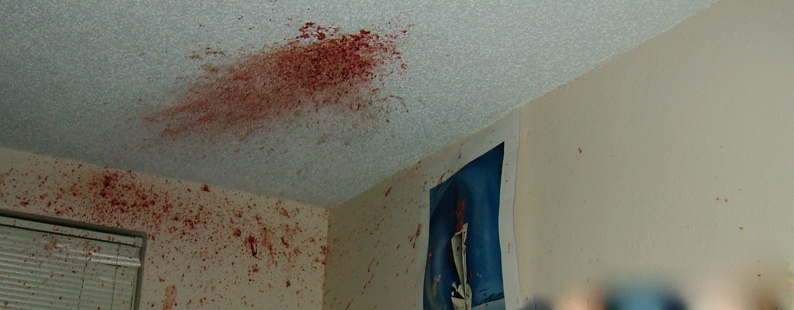© 2010 National Intelligence Agency Inc. All Rights Reserved.
Bloodstain Pattern Analysis
surfaces to determine how a particular criminal act was perpetrated. Additionally, bloodstain pattern analyses often involve familiarity with other forensic disciplines. Bloodstain pattern analysis used properly, aids in establishing the sequence of specific events associated with the enactment of a violent crime that involves bloodshed. Bloodstain pattern analysis evidence can provide a retrospective view of events as they likely unfolded based on visualizing an incident as it may have taken place. Dispersion, shape, characteristics, volume, pattern, the number of bloodstains and their relationship to the surrounding scene, all contribute to the assessment of a crime scene that involves blood. The information likely to be discovered through bloodstain pattern analysis involves:
* The direction a given droplet traveled in space at the time a blow was delivered.
* Pattern outlined evidence at impact site.
* The angle of impact.
* The probable distance between the target and the droplet's origination.
* The nature of the force applied in propelling the bloodshed.
* The direction from which the force was applied.
* The nature of the object used in executing the force.
* The approximate number of blows inflicted during the incident.
* The relative position of the suspect to the victim to the surrounding physical environment during
the incident.
* And, sometimes which hand delivered the blows from a beating or striking.
Crime scene reconstruction requires evaluation of all physical and testimonial evidence to derive a satisfactory conclusion relative to what occurred. Bloodstain pattern analysis is but one aspect of this often-complex puzzle. Inconsistencies between the story told and the physical evidence that presents itself, will often reveal obvious discrepancies from which to infer ill conceived memory of events or outright deception on the part of those involved.
What purpose does Bloodstain Pattern Analysis serve?
As mentioned previously, Bloodstain Pattern Analysis makes apparent or reveals inconsistencies in testimonial evidence. Additionally, Bloodstain Pattern Analysis brings to an investigation the ability to define those events that could or could not have taken place during the course of the bloodshed. Once identified, these facts are considered in light of other evidence as a means of corroborating or refuting statements, confessions or investigative theories. In short, bloodstain patterns analysis provides scientific evidence against which a witness or suspect's statements can be evaluated to derive clues in a search for truth or a potential suspect. And, lastly, Bloodstain Pattern Analysis seeks to answer the question, “What happened?”.
Who does Bloodstain Pattern Analysis serve?
Bloodstain Patterns Analysis is utilized by a full compliment of legal professionals and Law Enforcement entities. Bloodstain Pattern Analysis is often employed by prosecuting attorneys, defense attorneys and criminalists working for law enforcement agencies who perform investigations and assist in comprehensive case development.
Bloodstain Pattern Analysis is used to determine the type of charges filed, outline courtroom testimony, and is invaluable to legal historians or "cold case" investigators who query cases based upon photographic evidence from past crime scenes. It is essential to understand that Bloodstain Pattern Analysis does not work in isolation or stand alone to the exclusion of other forensic disciplines in the pursuit of truth and justice.
Contact The National Intelligence Agency, Inc. (NIA) when seeking expertise in procuring immediate and/or retroactive "cold case" Bloodstain Pattern Analysis of a crime scene.
What is it?
The primary objective of forensic bloodstain pattern analysis is in seeking the truth behind a crime through crime scene reconstruction. This objective is accomplished by applying known laws of physics to visible bloodstain patterns left on


